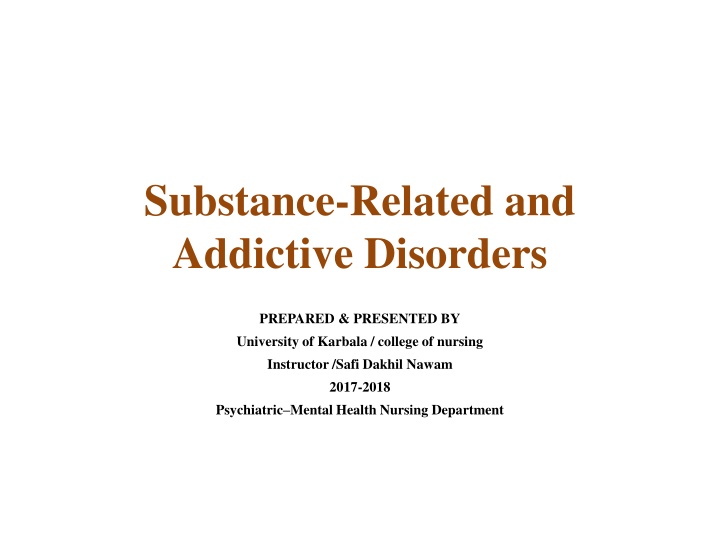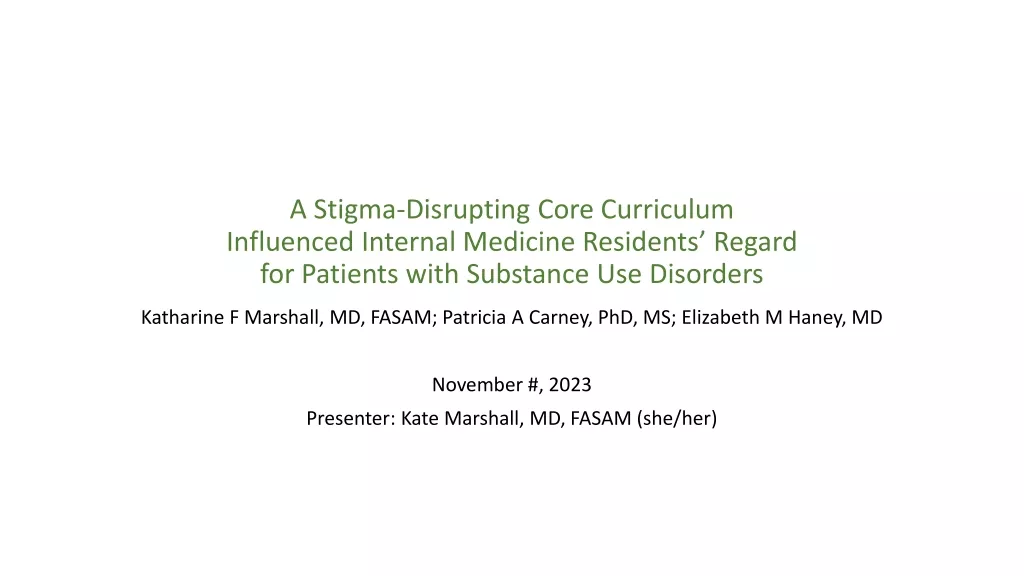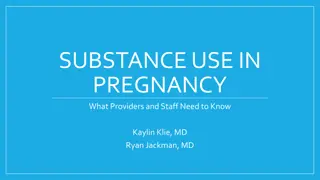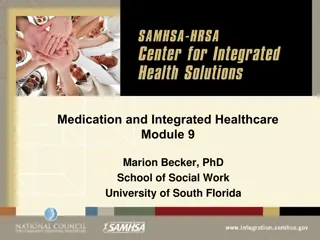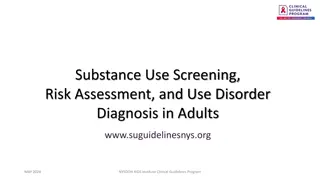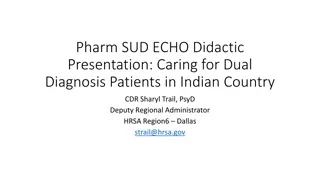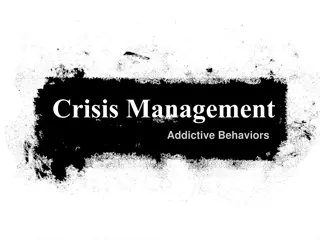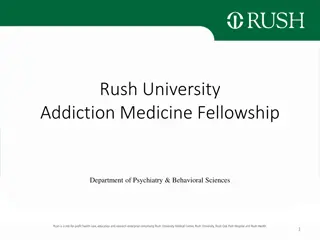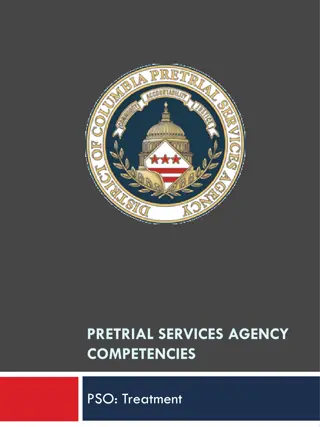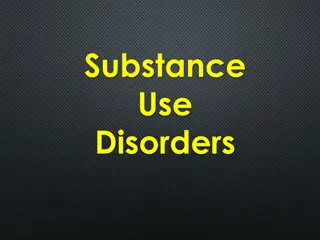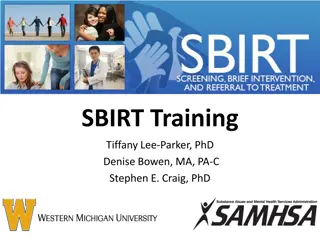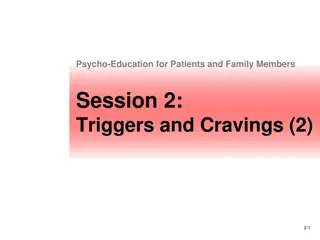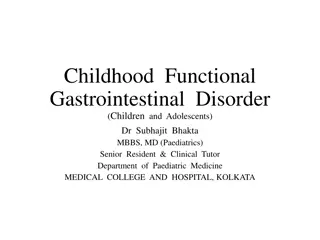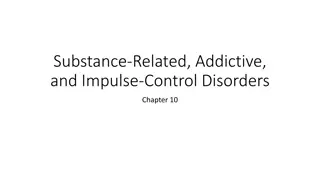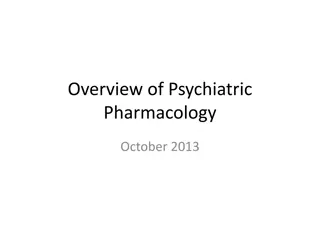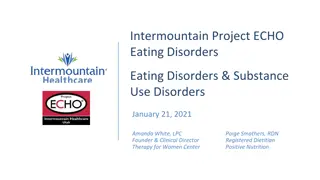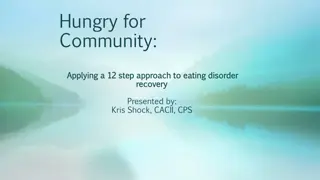Substance-Related and Addictive Disorders Overview
Substance-related disorders encompass substance use disorders and substance-induced disorders, with a focus on addiction, intoxication, withdrawal, and treatment modalities. Explore the complexities of addiction and its impact on individuals.
Download Presentation

Please find below an Image/Link to download the presentation.
The content on the website is provided AS IS for your information and personal use only. It may not be sold, licensed, or shared on other websites without obtaining consent from the author.If you encounter any issues during the download, it is possible that the publisher has removed the file from their server.
You are allowed to download the files provided on this website for personal or commercial use, subject to the condition that they are used lawfully. All files are the property of their respective owners.
The content on the website is provided AS IS for your information and personal use only. It may not be sold, licensed, or shared on other websites without obtaining consent from the author.
E N D
Presentation Transcript
Substance-Related and Addictive Disorders PREPARED & PRESENTED BY University of Karbala / college of nursing Instructor /Safi Dakhil Nawam 2017-2018 Psychiatric Mental Health Nursing Department
OUTLINE Objectives Introduction Substance-Use Disorder, Defined Substance-Induced Disorder, Defined Classes of Psychoactive Substances Predisposing Factors to Substance-Related Disorders The Dynamics of Substance-Related Disorders Application of the Nursing Process Treatment Modalities for Substance-Related Disorders Non-Substance Addictions
OBJECTIVES Define addiction, intoxication, and withdrawal. Discuss predisposing factors implicated in the etiology of substance-related and addictive disorders. Identify symptomatology and use the information in assessment of clients with various substance-related and addictive disorders. Identify nursing diagnoses common to clients with substance-related and addictive disorders and select appropriate nursing interventions for each. Identify topics for client and family teaching relevant to substance-related and addictive disorders. Describe relevant outcome criteria for evaluating nursing care of clients with substance-related and addictive disorders. Discuss the issue of substance-use and addictive disorders within the profession of nursing. Define codependency and identify behavioral characteristics associated with the disorder. Discuss treatment of codependency. 10. Describe various modalities relevant to treatment of individuals with substance related and addictive disorders. 1. 2. 3. 4. 5. 6. 7. 8. 9.
Introduction Substance-related disorders are composed of two groups: substance use disorders (addiction) substance-induced disorders delirium, neurocognitive disorder [NCD], psychosis, bipolar disorder, depressive disorder, obsessive-compulsive disorder [OCD], anxiety disorder, sexual dysfunction, and sleep disorders). This lesson we will discusses addiction, intoxication, and withdrawal. Also included in this chapter is a discussion of gambling disorder, a non-substance addiction disorder. (intoxication, withdrawal,
Substance Use Disorder, Defined Substance addiction: The diagnostic and statistical manual of mental disorders, fifth edition (DSM-5) (american psychiatric association [APA], 2013) lists diagnostic criteria for addiction to specific substances, including alcohol, cannabis, hallucinogens, inhalants, opioids, sedative/hypnotics, stimulants, and tobacco. 1. Individuals are considered to have a substance-use disorder when use of the substance interferes with their ability to fulfill role obligations, such as at work, school, or home. 2. Often the individual would like to cut down or control use of the substance, but attempts fail, and use of the substance continues to increase. 3. There is an intense craving for the substance. 4. Excessive amount of time is spent trying to procure more of the substance or recover from the effects of its use. 5. Use of the substance causes problems with interpersonal relationships. 6. Individual may become socially isolated. 7. Individuals with substance-use disorders often participate in hazardous activities when impaired by the substance, 8. Continue to use the substance despite knowing that its use is contributing to a physical or psychological problem. 9. Addiction is evident when tolerance develops and the amount required to achieve the desired effect continues to increase.
Substance-Induced Disorders, Defined Substance Intoxication Substance intoxication is defined as the development of a reversible syndrome of symptoms following excessive use of a substance. The symptoms are drug-specific, and occur during or shortly after the ingestion of the substance. There is a direct effect on the CNS, and a disruption in physical and psychological functioning occurs. Judgment is disturbed, resulting in inappropriate and maladaptive behavior, and social and occupational functioning are impaired.
Substance-Induced Disorders, Defined cont. Substance Withdrawal Substance reduction or discontinuation of a substance that has been used regularly over a prolonged period of time. The substance-specific clinically significant physical signs and symptoms as well as psychological changes, such as disturbances in thinking, feeling, and behavior. upon withdrawal occurs abrupt syndrome includes
Classes of Psychoactive Substances The associated disorders: 1. Alcohol 2. Caffeine 3. Cannabis 4. Hallucinogens 5. Inhalants 6. Opioids 7. Sedative-hypnotics 8. Stimulants 9. Tobacco following classes substance-use of psychoactive and substances substance are with induced
Predisposing Factors to Substance- Related Disorders 1. Biological Factors Genetics Biochemical: alcohol may produce morphine-like substances in the brain that are responsible for alcohol addiction. 2. Psychological Factors Developmental Influences Personality Factors 3. Sociocultural Factors Social Learning Conditioning Cultural and Ethnic Influences
The Dynamics of Substance-Related Disorders 1. Alcohol Use Disorder
1. Alcohol Use Disorder A Profile of the Substance Historical Aspects Patterns of Use: Jellinek (1952) outlined four phases through which the alcoholic s pattern of drinking progresses. Phase I. The Pre-alcoholic Phase This phase is characterized by the use of alcohol to relieve the everyday stress and tensions of life. As a child, the individual may have observed parents or other adults drinking alcohol and enjoying the effects. The child learns that use of alcohol is an acceptable method of coping with stress. Tolerance develops, and the amount required to achieve the desired effect increases gradually.
four phases cont. Phase II. The Early Alcoholic Phase This phase begins with blackouts brief periods of amnesia that occur during or immediately following a period of drinking. Now the alcohol is no longer a source of pleasure or relief for the individual but rather a drug that is required by the individual. Common behaviors include sneaking drinks or secret drinking, preoccupation with drinking and maintaining the supply of alcohol, rapid gulping of drinks, and further blackouts. The individual feels enormous guilt and becomes very defensive about his or her drinking. Excessive use of denial and rationalization is evident.
four phases cont. Phase III. The Crucial Phase In this phase, the individual has lost control, and physiological addiction is clearly evident. This loss of control has been described as the inability to choose whether or not to drink. Binge drinking, lasting from a few hours to several weeks, is common. These episodes are characterized by sickness, loss of consciousness, squalor, and degradation. In this phase, the individual is extremely ill. Anger and aggression are common manifestations. Drinking is the total focus, and he or she is willing to risk losing everything that was once important, in an effort to maintain the addiction. By this phase of the illness, it is not uncommon for the individual to have experienced the loss of job, marriage, family, friends, and most especially, self-respect.
four phases cont. Phase IV. The Chronic Phase This phase is characterized by emotional and physical disintegration. The individual is usually intoxicated more than he or she is sober. Emotional disintegration is evidenced by profound helplessness and self-pity. Impairment in reality testing may result in psychosis. Life-threatening physical manifestations may be evident in virtually every system of the body. Abstention from alcohol results in a terrifying syndrome of symptoms that include hallucinations, tremors, convulsions, severe agitation, and panic. Depression and ideas of suicide are not uncommon
Effects on the Body Peripheral Neuropathy Alcoholic Myopathy Encephalopathy Korsakoff s Psychosis Alcoholic Cardiomyopathy Esophagitis Gastritis Pancreatitis Alcoholic Hepatitis Cirrhosis of the Liver Leukopenia Thrombocytopenia Sexual Dysfunction
Use During Pregnancy Fetal Alcohol Syndrome Prenatal exposure to alcohol can result in a broad range of disorders to the fetus, known as fetal alcohol spectrum disorders (FASDs), the most common of which is fetal alcohol syndrome (FAS). Fetal alcohol syndrome includes physical, mental, behavioral, and/or learning disabilities with lifelong implications. There may be problems with learning, memory, attention span, communication, vision, hearing, or a combination of these (Centers for Disease Control and Prevention [CDC], 2011a). Other FASDs include alcohol-related neurodevelopmental disorder (ARND) and alcohol-related birth defects (ARBD).
Alcohol Intoxication Symptoms of alcohol intoxication include disinhibition of sexual or aggressive impulses, mood liability, impaired judgment, impaired social or occupational functioning, slurred speech, incoordination, unsteady gait, nystagmus, and flushed face. Intoxication usually occurs at blood alcohol levels between 100 and 200 mg/dL. Death has been reported at levels ranging from 400 to 700 mg/dL.
Alcohol Withdrawal Within 4 to 12 hours of cessation of, or reduction in, heavy and prolonged (several days or longer) alcohol use, the following symptoms may appear: coarse tremor of hands, tongue, or eyelids; nausea or vomiting; malaise or weakness; tachycardia; sweating; elevated blood pressure; anxiety; depressed mood or irritability; transient hallucinations or illusions; headache; and insomnia. A complicated withdrawal syndrome may progress to alcohol withdrawal delirium. Onset of delirium is usually on the second or third day following cessation of or reduction in prolonged, heavy alcohol use. Symptoms include those described under the syndrome of delirium
The Dynamics of Substance-Related Disorders 2. Sedative, Hypnotic, or Anxiolytic Use Disorder
Sedative, Hypnotic, or Anxiolytic Use Disorder A Profile of the Substance The sedative, hypnotic, and anxiolytic compounds are drugs of diverse chemical structures that are all capable of inducing varying degrees of CNS depression, from tranquilizing relief of anxiety to anesthesia, coma, and even death. They are generally categorized as: (1) barbiturates, (2) non barbiturate hypnotics, (3) antianxiety agents.
A Profile of the Substance cont. Several principles have been identified that apply fairly uniformly to all CNS depressants: 1. The effects of CNS depressants are additive with one another and with the behavioral state of the user: For example, when these drugs are used in combination with each other or in combination with alcohol, the depressive effects are compounded. These intense depressive effects are often unpredictable and can even be fatal. Similarly, a person who is mentally depressed or physically fatigued may have an exaggerated response to a dose of the drug that would only slightly affect a person in a normal or excited state.
A Profile of the Substance cont. Several principles have been identified that apply fairly uniformly to all CNS depressants 2. CNS depressants are capable of producing physiological addiction: If large doses of CNS depressants are repeatedly administered over a prolonged duration, a period of CNS hyperexcitability occurs on withdrawal of the drug. The response can be quite severe, even leading to convulsions and death. 3. CNS depressants are capable of producing psychological addiction: CNS depressants have the potential to generate within the individual a psychic drive for periodic or continuous administration of the drug to achieve a maximum level of functioning or feeling of well-being. 4. Cross-tolerance and cross-dependence may exist between various CNS depressants: Cross-tolerance is exhibited when one drug results in a lessened response to another drug. Cross-dependence is a condition in which one drug can prevent withdrawal symptoms associated with physical addiction to a different drug (Julien, 2008). :
Historical Aspects Patterns of Use Effects on the body: The Effects on Sleep and Dreaming Respiratory Depression Cardiovascular Effects Renal Function Hepatic Effects Body Temperature Sexual Functioning
Sedative, Hypnotic, or Anxiolytic Intoxication The DSM-5 (APA, 2013) describes sedative, hypnotic, or anxiolytic intoxication as the presence of clinically significant maladaptive behavioral or psychological changes that develop during, or shortly after, use of one of these substances. These maladaptive changes may include inappropriate sexual or aggressive behavior, mood liability, impaired judgment, or impaired social or occupational functioning. Other symptoms that may develop with excessive use of CNS depressants include slurred speech, incoordination, unsteady gait, nystagmus, impairment in attention or memory, and stupor or coma.
Sedative, Hypnotic, or Anxiolytic Withdrawal Withdrawal from sedatives, hypnotics, or anxiolytics produces a characteristic syndrome of symptoms that develops after a reduction in or cessation of intake that has been heavy or prolonged (APA, 2013). Onset of the symptoms depends on the drug from which the individual is withdrawing. With short-acting sedative-hypnotics (e.g., alprazolam, lorazepam), symptoms may begin between 12 and 24 hours after the last dose, reach peak intensity between 24 and 72 hours, and subside in 5 to 10 days. Withdrawal symptoms from substances with longer half-lives (e.g., diazepam, phenobarbital, chlordiazepoxide) may begin within 2 to 7 days, peak on the fifth to eighth day, and subside in 10 to 16 days (Gualtieri, 2004; Leamon, Wright, & Myrick, 2008).
The Dynamics of Substance-Related Disorders 3. Stimulant Use Disorder
3. Stimulant Use Disorder A Profile of the Substance Historical Aspects Patterns of Use Effects on the Body: CNS Effects Cardiovascular/Pulmonary Effects Gastrointestinal and Renal Effects Sexual Functioning
Stimulant Withdrawal Stimulant withdrawal is the presence of a characteristic withdrawal syndrome that develops within a few hours to several days after cessation of, or reduction in, heavy and prolonged use (APA, 2013). Black and Andreasen (2011) state, Cessation or reduction of amphetamine (or cocaine) use may lead to a withdrawal syndrome often referred to as a crash. Symptoms include fatigue and depression, nightmares, headache, profuse sweating, muscle cramps, and hunger. Withdrawal symptoms usually peak in 2 4 days. Intense dysphoria can occur, peaking between 48 and 72 hours after the last dose of the stimulant.
Application of the Nursing Process Assessment,Diagnosis/Outcome Identification Outcome Criteria The following criteria may be used for measurement of outcomes in the care of the client with substance-related disorders. The Client: has not experienced physical injury. has not caused harm to self or others. accepts responsibility for own behavior. acknowledges association between personal problems and use of substance(s). demonstrates more adaptive coping mechanisms that can be used in stressful situations (instead of taking substances). shows no signs or symptoms of infection or malnutrition. exhibits evidence of increased self-worth by attempting new projects without fear of failure and by demonstrating less defensive behavior toward others.
Application of the Nursing Process Planning/Implementation
Treatment Modalities for Substance- Related Disorders Alcoholics Anonymous Pharmacotherapy {Disulfiram (Antabuse)} Other Medications for Treatment of Alcoholism Counseling Group therapy Psychopharmacology for Substance Intoxication and Substance Withdrawal
Non-Substance Addictions Gambling Disorder This disorder is defined by the DSM-5 as persistent and recurrent problematic gambling behavior leading to clinically significant impairment or distress (APA, 2013). The preoccupation with and impulse to gamble often intensifies when the individual is under stress. Many impulsive gamblers describe a physical sensation of restlessness and anticipation that can only be relieved by placing a bet. In some cases the initial change in gambling behavior leading to pathological gambling begins with a big win, bringing a rapid development of preoccupation, tolerance, and loss of control. Winning brings feelings of special status, power, and omnipotence. The gambler increasingly depends on this activity to cope with disappointments, problems, and negative emotional states, pulling away from emotional attachment to family and friends.
Diagnostic Criteria for Gambling Disorder A. Persistent and recurrent problematic gambling behavior leading to clinically significant impairment or distress, as indicated by the individual exhibiting four (or more) of the following in a 12-month period: 1. Needs to gamble with increasing amounts of money in order to achieve the desired excitement. 2. Is restless or irritable when attempting to cut down or stop gambling. 3. Has made repeated unsuccessful efforts to control, cut back, or stop gambling. 4. Is often preoccupied with gambling (e.g., persistent thoughts of reliving past gambling experiences, handicapping or planning the next venture, or thinking of ways to get money with which to gamble). 5. Often gambles when feeling distressed (e.g., helpless, guilty, anxious, depressed). 6. After losing money gambling, often returns another day to get even ( chasing one s losses). 7. Lies to conceal the extent of involvement with gambling. 8. Has jeopardized or lost a significant relationship, job, or educational or career opportunity because of gambling. 9. Relies on others to provide money to relieve desperate financial situations caused by gambling. B. The gambling behavior is not better explained by a manic episode. Specify if: Episodic: meeting diagnostic criteria at more than one time point, with symptoms subsiding between periods of gambling disorder for at least several months. Persistent: Experiencing continuous symptoms, to meet diagnostic criteria for multiple years.
